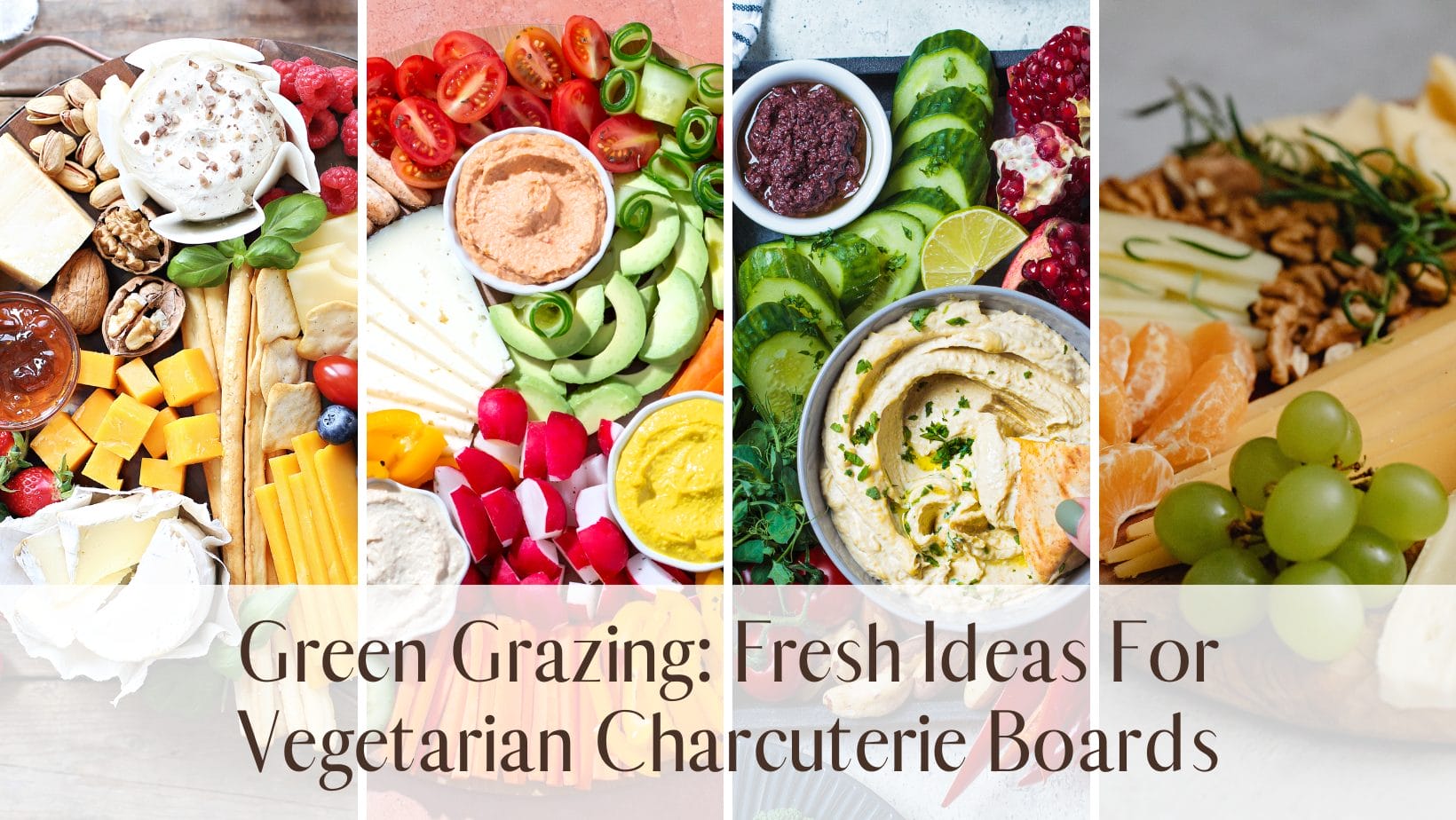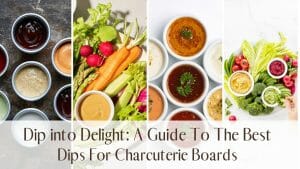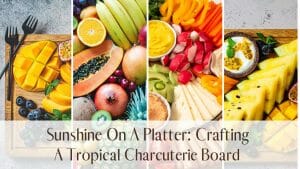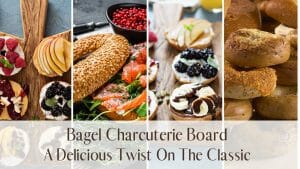Charcuterie boards have taken the culinary world by storm, becoming a staple at parties, picnics, and cozy nights in. While traditionally laden with meats, a vegetarian charcuterie board offers a fresh, colorful, and health-conscious alternative that’s just as delicious and visually appealing. Whether you're a dedicated vegetarian or simply looking to incorporate more plant-based options into your gatherings, our ultimate guide will walk you through everything you need to know to create a stunning vegetarian charcuterie board that will impress your guests and delight your taste buds. Let's dive into the world of vibrant vegetables, delectable cheeses, and flavorful dips to craft the perfect spread!
TIP: Unlock the art of charcuterie quickly and join over 514K enthusiasts! Click here to elevate your food art game now >>
Table of Contents [CLICK HERE TO OPEN]
- What is a Vegetarian Charcuterie Board?
- Benefits of a Vegetarian Charcuterie Board
- Essential Ingredients for a Vegetarian Charcuterie Board
- Step-by-Step Guide to Assembling a Vegetarian Charcuterie Board
- Themed Vegetarian Charcuterie Boards for Every Occasion
- Vegan Charcuterie Board Options
- Vegetarian Charcuterie Boards for Parties and Gatherings
- Common Questions and FAQs About Vegetarian Charcuterie Boards
- Wrapping It Up
- Frequently Asked Questions
What is a Vegetarian Charcuterie Board?
Definition and Key Components
A vegetarian charcuterie board is a delightful and visually appealing platter that substitutes traditional meat items with a variety of plant-based options. Key components typically include:
- Vegetables: Fresh, colorful vegetables such as bell peppers, cherry tomatoes, cucumbers, and carrots add crunch and flavor.
- Fruits: Fresh and dried fruits like grapes, apples, berries, and figs provide sweetness and variety.
- Cheeses: A selection of cheeses, including options like brie, cheddar, goat cheese, and vegan alternatives, offers richness and creaminess.
- Crackers and Bread: Whole grain crackers, artisanal bread, and gluten-free options serve as the perfect base for toppings.
- Dips and Spreads: Hummus, guacamole, pesto, and other flavorful dips enhance the taste and texture of the board.
- Nuts and Seeds: Almonds, walnuts, sunflower seeds, and other nuts add a satisfying crunch.
- Sweet Additions: Items like dark chocolate, honey, and dried fruits provide a sweet contrast.
Differences from Traditional Charcuterie Boards
While traditional charcuterie boards are known for their selection of cured meats, a vegetarian charcuterie board focuses on plant-based ingredients, creating a lighter and often more colorful spread. Key differences include:
- No Meat: Instead of salami, prosciutto, and other meats, vegetarian boards feature an array of vegetables, fruits, and plant-based proteins.
- Emphasis on Freshness: Fresh, raw vegetables and fruits are more prominent, highlighting seasonal produce.
- Variety of Cheeses: While traditional boards may have some cheese, vegetarian boards often have a more extensive selection, including dairy-free options.
- More Dips and Spreads: Vegetarian boards tend to incorporate a greater variety of dips and spreads to add flavor and texture.
Brief History and Evolution
The concept of a charcuterie board dates back to 15th-century France, where “charcutiers” prepared and sold cured meats and other preserved foods. These traditional boards evolved to include a variety of accompaniments like cheese, fruits, and nuts, catering to different tastes and preferences.
In recent years, the rise of vegetarian and plant-based diets has led to the evolution of the charcuterie board into a more inclusive culinary experience. Vegetarian charcuterie boards have become increasingly popular as people seek healthier, more sustainable, and visually stunning options for entertaining. These boards not only offer a feast for the eyes but also provide a diverse range of flavors and textures, making them a hit at parties, picnics, and casual gatherings.
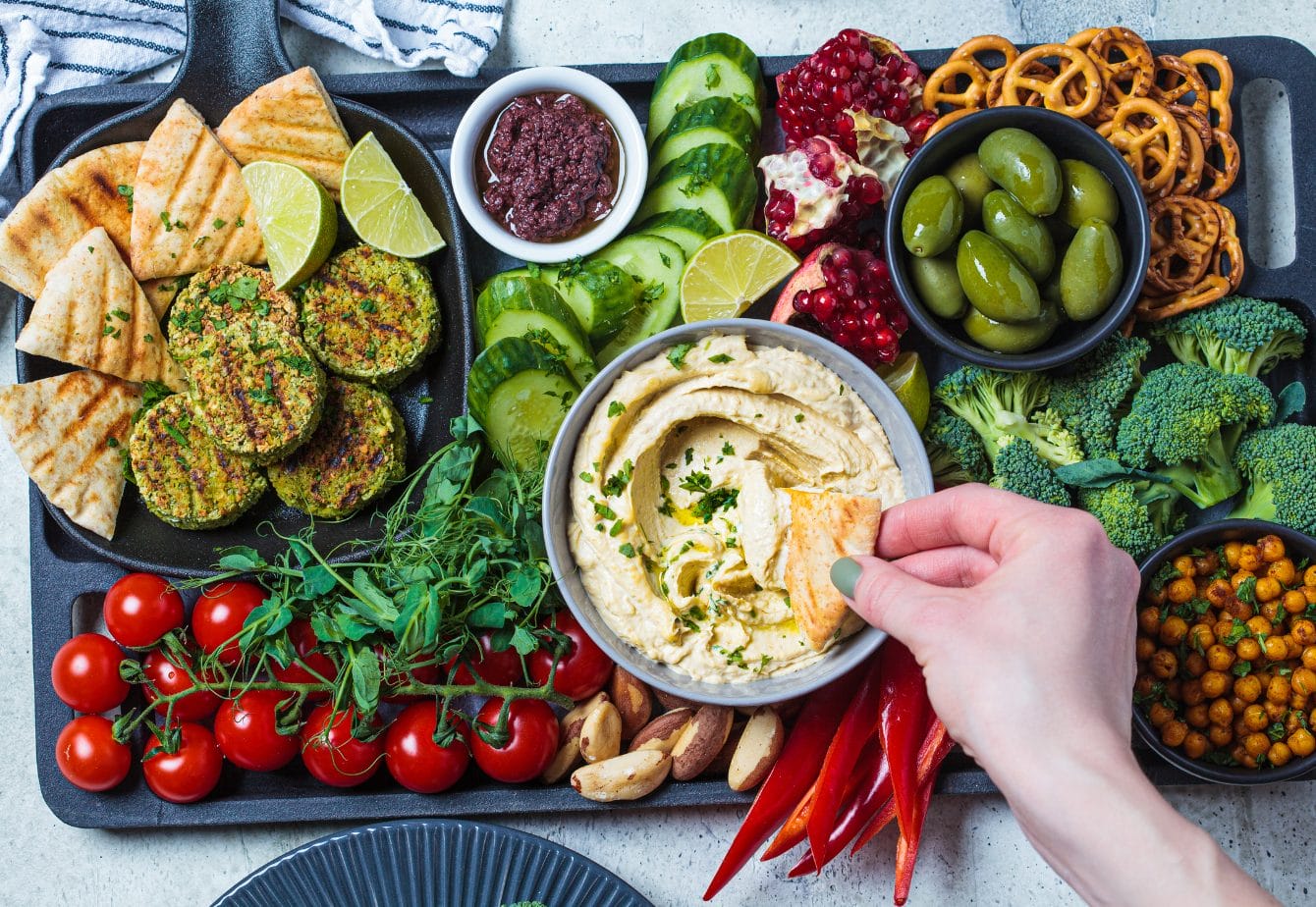
Benefits of a Vegetarian Charcuterie Board
Health Benefits of Vegetarian Ingredients
A vegetarian charcuterie board offers numerous health benefits due to its focus on plant-based ingredients:
- Nutrient-Rich: Fresh vegetables and fruits are packed with essential vitamins, minerals, and antioxidants that support overall health and well-being.
- Lower in Saturated Fat: By eliminating meats and high-fat cheeses, a vegetarian charcuterie board is typically lower in saturated fats, which can contribute to heart health.
- Rich in Fiber: Vegetables, fruits, nuts, and seeds provide dietary fiber, which aids in digestion and helps maintain a healthy weight.
- Reduced Risk of Chronic Diseases: A diet high in plant-based foods is associated with a lower risk of chronic conditions such as diabetes, hypertension, and certain cancers.
Environmental and Ethical Advantages
Choosing a vegetarian charcuterie board also has positive impacts on the environment and aligns with ethical considerations:
- Lower Carbon Footprint: Plant-based diets generally have a smaller carbon footprint compared to meat-heavy diets, contributing to reduced greenhouse gas emissions.
- Conservation of Resources: Producing plant-based foods typically requires less land, water, and energy compared to animal farming, which helps in the conservation of natural resources.
- Animal Welfare: Opting for a vegetarian board supports ethical practices by avoiding animal products and reducing demand for factory-farmed meats.
Versatility and Creativity in Presentation
A vegetarian charcuterie board is highly versatile and allows for creative expression in both design and flavor:
- Endless Combinations: With a wide array of vegetables, fruits, cheeses, dips, and nuts, there are countless combinations to suit various tastes and dietary preferences.
- Seasonal and Themed Options: You can tailor the board to different seasons or themes, incorporating seasonal produce and special ingredients for holidays or events.
- Visual Appeal: The vibrant colors and varied textures of a vegetarian board make it a stunning centerpiece for any gathering. Creative arrangement and garnishing can enhance its aesthetic appeal, making it both a feast for the eyes and the palate.
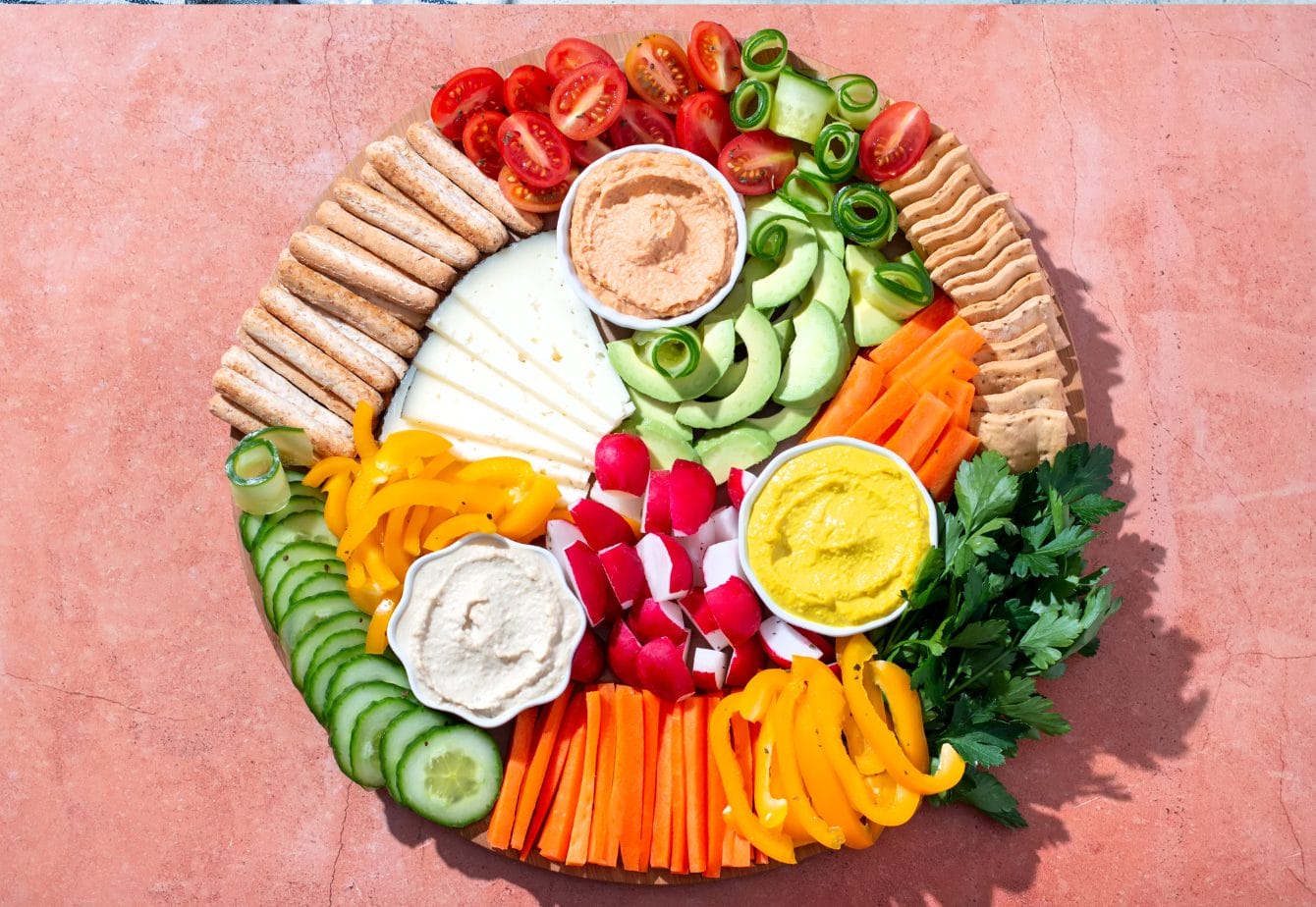
Essential Ingredients for a Vegetarian Charcuterie Board
Creating a vibrant and satisfying vegetarian charcuterie board involves selecting a variety of fresh, flavorful, and visually appealing ingredients. Here are the key components to include:
Vegetables
Vegetables add crunch, color, and a range of nutrients to your charcuterie board. Consider including:
- Bell Peppers: Slice them into strips or wedges for a crisp and sweet flavor.
- Cucumbers: Cut into rounds or sticks for a refreshing crunch.
- Cherry Tomatoes: These bite-sized tomatoes offer juiciness and a burst of sweetness.
Fruits
Fruits provide natural sweetness and vibrant color, balancing out the savory components. Try:
- Grapes: Easy to eat and perfect for adding a touch of sweetness.
- Apples: Sliced apples offer a crisp texture and mild sweetness.
- Berries: Include a mix of strawberries, blueberries, and raspberries for a burst of flavor and color.
Cheeses
Cheese adds richness and variety. Choose from:
- Brie: Soft and creamy, brie provides a luxurious texture.
- Cheddar: Sharp and tangy, cheddar offers a robust flavor.
- Vegan Cheese: For a plant-based option, explore dairy-free cheeses made from nuts or soy.
Crackers and Bread
These serve as the base for your cheeses and spreads. Opt for:
- Whole Grain Crackers: Nutty and hearty, these add texture and flavor.
- Gluten-Free Options: Ensure inclusivity with gluten-free crackers or bread choices.
- Artisanal Bread: Sliced baguettes or rustic loaves can elevate the board’s presentation.
Dips and Spreads
Dips and spreads enhance the board with additional flavors and textures. Include:
- Hummus: A creamy and versatile spread made from chickpeas.
- Guacamole: Rich and flavorful, guacamole pairs well with vegetables and crackers.
- Pesto: Made from basil, pine nuts, and olive oil, pesto adds a herby kick.
Nuts and Seeds
Nuts and seeds offer crunch and a boost of protein. Consider:
- Almonds: Lightly salted or raw, almonds provide a satisfying crunch.
- Sunflower Seeds: These add a nutty flavor and are a good source of healthy fats.
- Walnuts: Rich and slightly bitter, walnuts balance the sweetness of fruits.
Sweet Additions
Sweet elements add a delightful contrast to the savory items on the board. Include:
- Dried Fruits: Such as apricots, figs, or dates, for a chewy texture and natural sweetness.
- Dark Chocolate: Small pieces or squares offer a rich and indulgent treat.
- Honey: A drizzle of honey can complement cheeses and fruits with its sweet, floral notes.
By incorporating these essential ingredients, you can create a well-rounded, visually appealing, and delicious vegetarian charcuterie board that is sure to please any crowd.
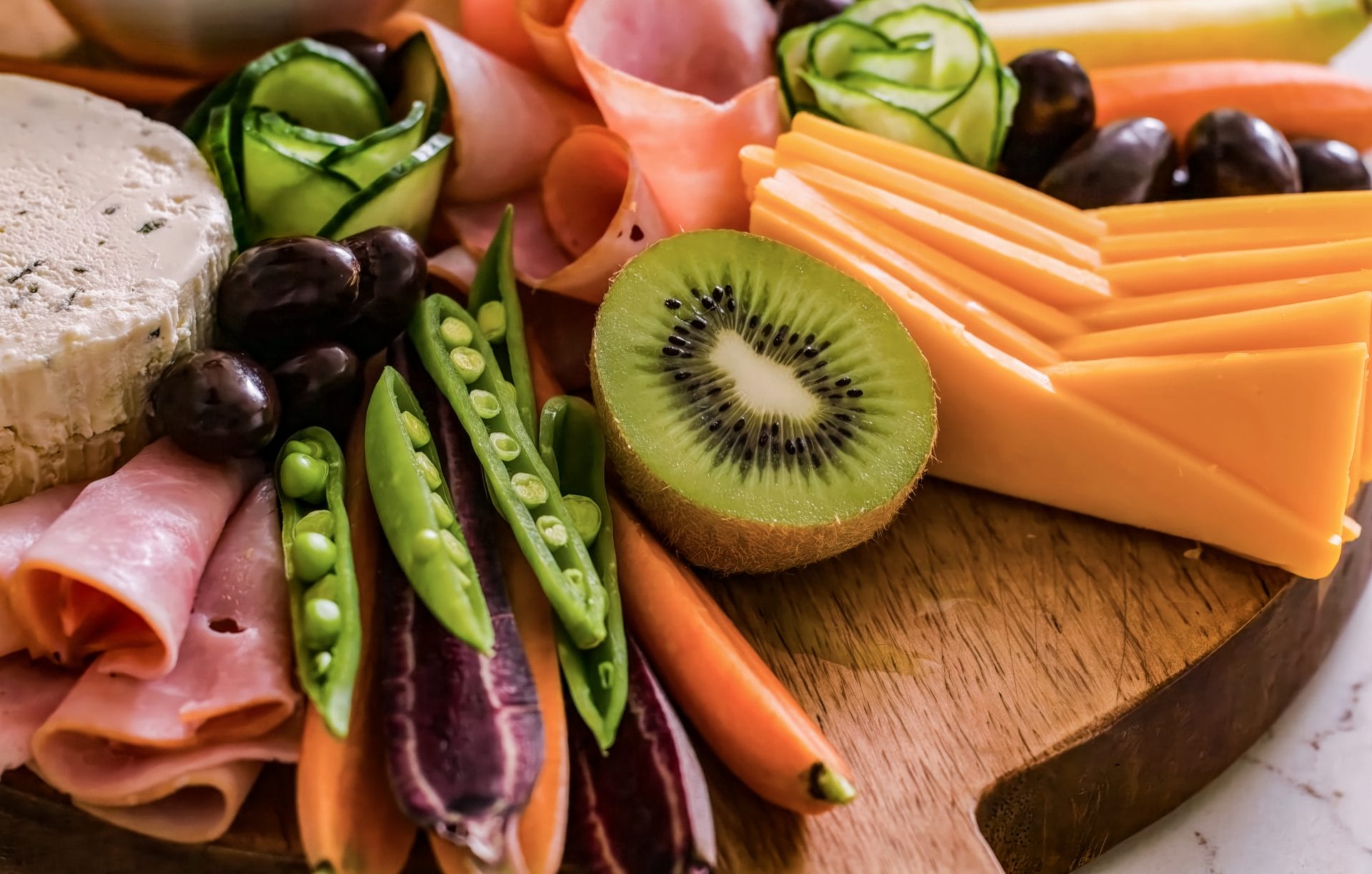
Step-by-Step Guide to Assembling a Vegetarian Charcuterie Board
Creating a stunning vegetarian charcuterie board is both an art and a science, combining flavors, textures, and colors to create a visually pleasing and delicious spread. Here’s a detailed guide to help you assemble the perfect board:
Preparation Tips
Slicing and Dicing
- Vegetables: For an appealing presentation, slice vegetables into uniform pieces. Thinly slice bell peppers into strips or wedges, cut cucumbers into rounds or sticks, and halve cherry tomatoes. This uniformity not only makes the board look neat but also ensures an even distribution of flavors.
- Fruits: Slice apples into wedges or thin slices to make them easy to eat. For fruits like grapes or berries, simply rinse them and arrange them whole. Consider cutting larger fruits, like pears, into bite-sized pieces to match the rest of the spread.
- Cheeses: Cut cheeses into a variety of shapes and sizes. For example, slice a block of cheddar into small squares or triangles, and cut brie into wedges. For vegan cheeses, slice or cube them in similar fashion to blend seamlessly with the other items.
Arranging Items for Visual Appeal
- Balance and Symmetry: Start by placing larger items, such as blocks of cheese or bowls of dips, in the center of the board. Arrange smaller items, like crackers and nuts, around these focal points. This creates a sense of balance and makes it easier for guests to access different components.
- Grouping Similar Items: Group similar items together, such as placing all the fruits in one area and the vegetables in another. This organization not only looks attractive but also helps guests easily find what they’re looking for.
Assembly Instructions
Layering and Grouping
- Layering: Begin by layering the board with items of varying heights. Place some elements, like cheese blocks or bowls of dips, on small risers or cut pieces of cardboard to create visual depth. This layering adds dimension and prevents the board from looking flat.
- Grouping: Arrange items in clusters or groups rather than spreading them evenly across the board. For example, group all the nuts in one section and place the crackers and bread together. This method encourages people to sample a variety of items together, enhancing the overall tasting experience.
Balancing Colors and Textures
- Colors: Aim for a vibrant mix of colors to make the board visually striking. Use the bright reds of bell peppers, the deep greens of cucumbers, and the rich purples of grapes to create a dynamic color palette. Balance these colors across the board to ensure an even distribution.
- Textures: Incorporate a variety of textures to create a more interesting spread. Combine the crunchiness of vegetables and crackers with the creaminess of cheeses and dips. This contrast enhances the eating experience and keeps the palate engaged.
Presentation Tips
Using Different Shapes and Sizes
- Shapes: Incorporate a mix of shapes to add visual interest. Arrange cheese wedges next to round crackers, or place sliced fruits beside whole berries. Varying shapes prevents the board from looking monotonous and adds to its overall appeal.
- Sizes: Utilize different sizes of items to create a dynamic display. Place larger items like cheese blocks or bowls of dips in central locations, and scatter smaller items like nuts and fruit around them. This creates focal points and guides the eye across the board.
Adding Decorative Elements
- Edible Flowers: Use edible flowers, such as nasturtiums or pansies, to add a touch of elegance and color. Place them in small clusters around the board or scattered throughout to enhance its visual appeal.
- Herbs and Greens: Fresh herbs, like rosemary or basil, can be used as natural garnishes. Arrange sprigs of herbs around the board or use them as a backdrop to highlight other ingredients. Their aromatic quality adds an extra layer of sensory enjoyment.
By following these detailed steps, you’ll create a vegetarian charcuterie board that not only looks beautiful but also provides a delightful array of flavors and textures. Enjoy the process of assembling your board, and have fun experimenting with different ingredients and arrangements to make it uniquely your own.

Themed Vegetarian Charcuterie Boards for Every Occasion
Creating themed vegetarian charcuterie boards can add a special touch to any event or celebration. Here’s how to tailor your board to fit different seasons, holidays, regions, and audiences:
Seasonal Boards
Summer: Light and Refreshing Options
- Fruits: Include juicy summer fruits like watermelon, peaches, strawberries, and cantaloupe. Their bright colors and refreshing flavors are perfect for hot weather.
- Vegetables: Opt for crisp and cooling veggies such as cucumbers, bell peppers, and cherry tomatoes. Pair them with light dips like tzatziki or a yogurt-based ranch.
- Cheeses: Choose lighter cheeses like goat cheese or fresh mozzarella that complement the fresh produce.
- Extras: Add fresh herbs like mint or basil for a burst of flavor, and consider including chilled items like gazpacho in small cups for an extra refreshment.
Winter: Hearty and Warming Choices
- Fruits: Use seasonal fruits like apples, pears, and dried fruits such as figs and dates. These fruits offer a comforting sweetness.
- Vegetables: Include root vegetables like roasted carrots, sweet potatoes, and beets. These can be served warm or at room temperature.
- Cheeses: Incorporate richer cheeses like sharp cheddar or aged gouda, which pair well with winter flavors.
- Extras: Add warm dips such as a cheesy fondue or roasted red pepper dip, and include hearty bread like sourdough or rye.
Holiday Boards
Christmas: Festive and Colorful
- Fruits: Feature red and green fruits such as pomegranates, kiwi, and red grapes. Their vibrant colors evoke the holiday spirit.
- Vegetables: Use seasonal veggies like roasted Brussels sprouts, red bell peppers, and celery sticks. Add festive dips like a creamy spinach artichoke dip.
- Cheeses: Opt for festive cheeses such as herbed goat cheese or cranberry-infused cheese.
- Extras: Incorporate holiday-themed elements like edible gold stars or gingerbread cookies for a touch of festive charm.
Thanksgiving: Autumnal Flavors
- Fruits: Include seasonal fruits like apples, pears, and dried cranberries. Their flavors align perfectly with Thanksgiving.
- Vegetables: Serve roasted or pickled vegetables such as carrots, parsnips, and squash. Consider including a hearty dip like pumpkin hummus.
- Cheeses: Feature rich cheeses like brie or sharp cheddar that complement autumnal flavors.
- Extras: Add elements like spiced nuts or pecan-crusted cheese balls to evoke traditional Thanksgiving flavors.
Regional and Cultural Boards
Mediterranean: Olives, Feta, Pita
- Fruits: Use figs, olives, and grapes to capture Mediterranean flavors.
- Vegetables: Include marinated artichokes, roasted red peppers, and cucumber slices.
- Cheeses: Add feta cheese, along with a variety of olives.
- Extras: Serve with pita bread, hummus, tzatziki, and baba ganoush. Garnish with fresh herbs like rosemary and mint.
Asian-Inspired: Sushi Rolls, Edamame
- Fruits: Incorporate fruits like mango, lychee, or dragon fruit for a unique twist.
- Vegetables: Include items like pickled ginger, shredded carrots, and cucumber.
- Cheeses: For a unique touch, add a mild cheese such as cream cheese that complements sushi rolls.
- Extras: Add sushi rolls (vegan options like avocado rolls), edamame, seaweed snacks, and dipping sauces like soy sauce and wasabi.
Kid-Friendly Boards
Fun Shapes, Mild Flavors, Interactive Elements
- Fruits: Use easy-to-eat, kid-friendly fruits like apple slices, grapes, and berries. Consider using cookie cutters to create fun shapes.
- Vegetables: Include crunchy and mild veggies like baby carrots, cucumber rounds, and cherry tomatoes. Pair with a kid-friendly dip like ranch or hummus.
- Cheeses: Offer a selection of mild cheeses cut into fun shapes or served with toothpicks for easy grabbing.
- Extras: Add fun elements like pretzel sticks, popcorn, and mini crackers. Interactive items such as DIY cheese or fruit skewers can also make the board more engaging for kids.
By tailoring your vegetarian charcuterie board to suit these themes, you can create a memorable and enjoyable experience for any occasion or audience. Each theme allows for creative expression while ensuring that your board meets the tastes and preferences of your guests.
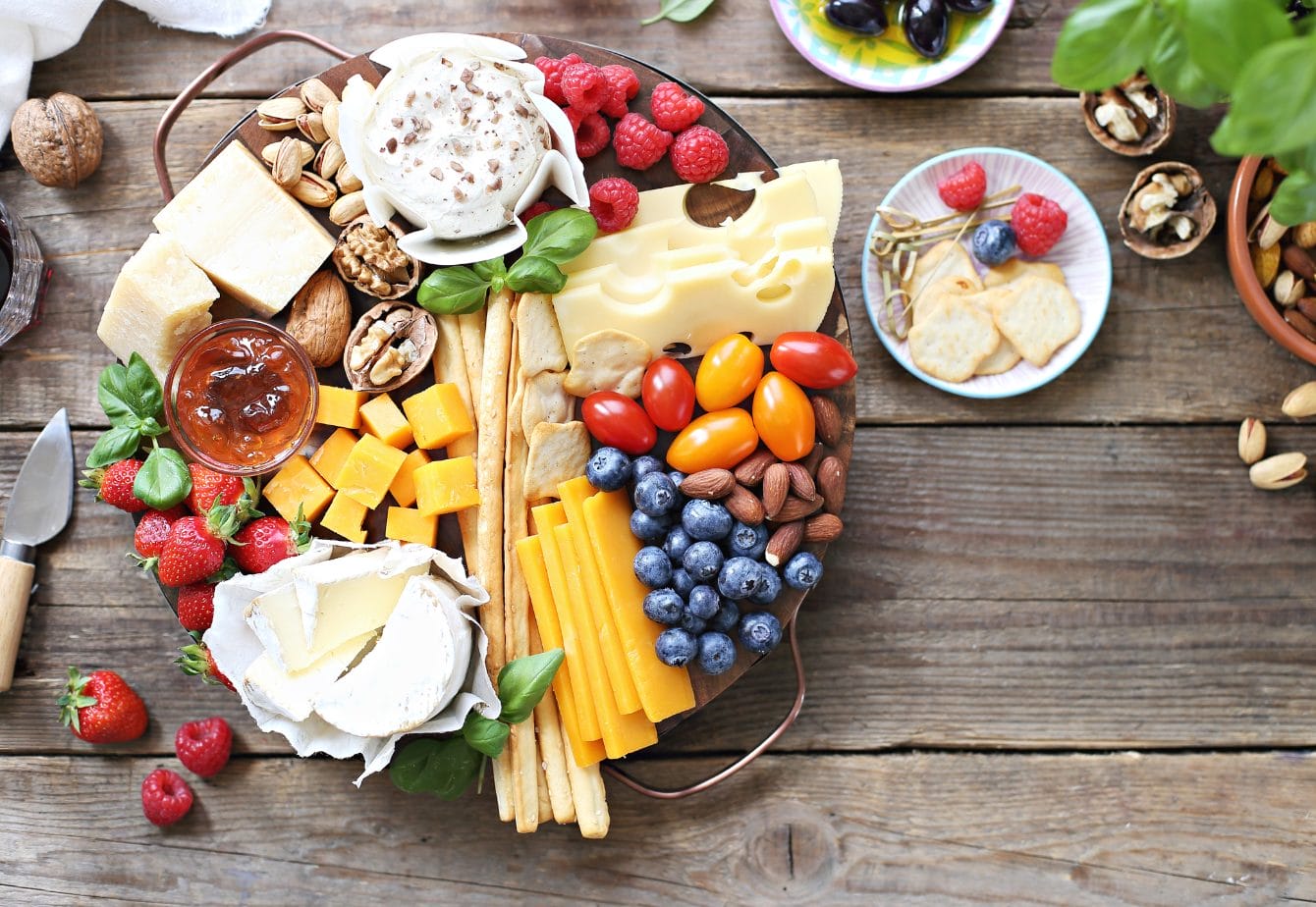
Vegan Charcuterie Board Options
When creating a vegan charcuterie board, the focus shifts from vegetarian options to strictly plant-based ingredients. Here’s how to make a delicious and visually appealing vegan charcuterie board, along with options and alternatives to ensure it meets all dietary requirements.
Differences Between Vegetarian and Vegan Charcuterie Boards
Vegan vs. Vegetarian: While both vegetarian and vegan charcuterie boards exclude meat, a vegan board goes a step further by eliminating all animal products. This means no dairy or honey, in addition to the absence of meat. The key differences include:
- Cheeses: Vegetarian boards may include dairy cheeses, whereas vegan boards use plant-based cheese alternatives.
- Dips and Spreads: Traditional dips may contain dairy or honey, so vegan versions use dairy-free alternatives and exclude honey.
- Sweet Additions: Vegan boards avoid honey and opt for other sweeteners like agave syrup or maple syrup.
Best Plant-Based Cheeses
Popular Brands and Homemade Recipes
- Popular Brands:
- Daiya: Known for its wide range of vegan cheeses, including shreds, slices, and blocks. Flavors like cheddar, mozzarella, and pepperjack are popular choices.
- Violife: Offers a variety of vegan cheese options, including creamy feta, cheddar, and mozzarella. Their cheeses are known for their rich flavors and textures.
- Miyoko’s Creamery: Specializes in artisanal vegan cheeses made from nuts, offering options like cashew-based brie and aged cheddar.
- Follow Your Heart: Provides a range of vegan cheeses, including American, mozzarella, and parmesan, known for their versatility and taste.
- Homemade Recipes:
- Cashew Cheese: Blend soaked cashews with nutritional yeast, lemon juice, garlic, and spices for a creamy, spreadable cheese.
- Almond Cheese: Blend almonds with a bit of water, lemon juice, and nutritional yeast, and season with herbs for a tangy, firm cheese.
- Vegan Cream Cheese: Made from blended tofu or cashews, flavored with lemon juice and herbs for a creamy spread.
Vegan Dips and Spreads
Dairy-Free Alternatives
- Hummus: A classic choice made from blended chickpeas, tahini, lemon juice, and garlic. Variants include roasted red pepper, spicy harissa, and herby green hummus.
- Guacamole: A creamy and flavorful option made from avocados, lime juice, tomatoes, onions, and cilantro.
- Pesto: Traditional pesto uses Parmesan cheese, but vegan versions substitute it with nutritional yeast or vegan Parmesan for a similar umami flavor.
- Bean Dips: Black bean or white bean dips can be seasoned with spices and herbs for a hearty, protein-packed spread.
- Vegan Creamy Spinach Dip: Made from cashews or tofu blended with spinach and herbs for a creamy, flavorful dip.
Vegan Meat Alternatives
Tempeh, Seitan, and Other Plant-Based Proteins
- Tempeh: Fermented soybeans pressed into a firm cake. It has a nutty flavor and can be sliced, marinated, and grilled or sautéed for a savory addition to your board.
- Seitan: Made from wheat gluten, seitan has a chewy texture and can be seasoned and cooked to mimic various meat flavors. It’s a great addition to a vegan charcuterie board for its protein content.
- Marinated Tofu: Pressed tofu marinated in soy sauce, spices, and herbs, then baked or grilled, offers a versatile protein source with a flavor boost.
- Vegan Sausages: Plant-based sausages made from a combination of soy, pea protein, and spices can add variety and a hearty texture to your board.
- Smoked Tempeh: Provides a robust, smoky flavor and chewy texture, making it a great addition to enhance the flavor profile of your vegan board.
By incorporating these vegan options, you can create a flavorful and inclusive charcuterie board that caters to those following a plant-based diet while ensuring a delicious experience for everyone.
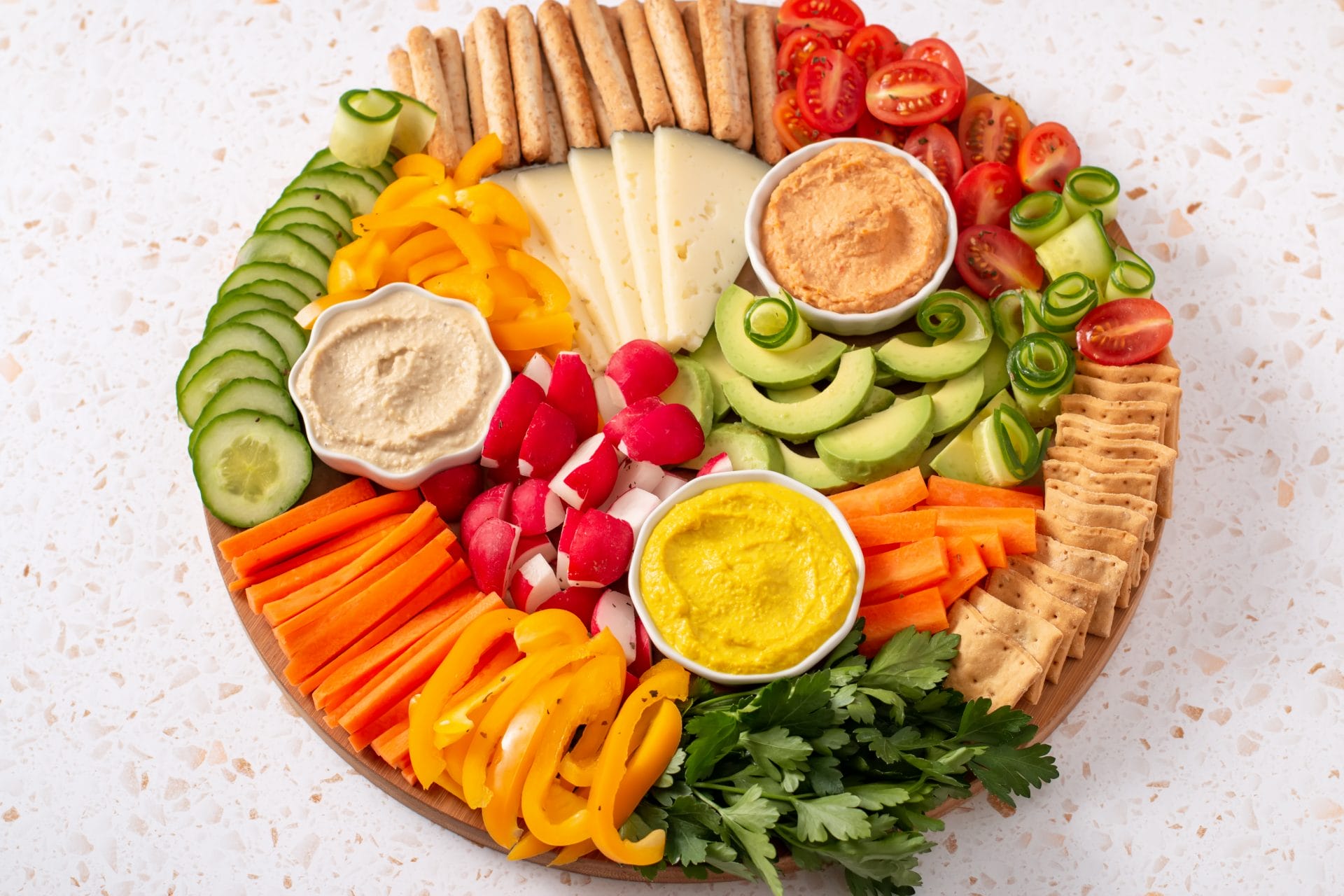
Vegetarian Charcuterie Boards for Parties and Gatherings
Creating a vegetarian charcuterie board for parties and gatherings involves more than just arranging ingredients—it’s about ensuring the board suits the scale of the event, complements the overall menu, and caters to various preferences. Here’s how to make your vegetarian charcuterie board a hit at any event:
Creating a Charcuterie Board for Parties
Scaling Up for Larger Groups
- Size and Quantity: For larger groups, opt for a larger board or multiple boards to accommodate the number of guests. Ensure you have enough of each item to go around, estimating about 4-6 ounces of cheese and 2-4 ounces of other ingredients per person.
- Variety: Include a wide range of ingredients to cater to different tastes. This can mean having multiple types of cheeses, a variety of fruits and vegetables, and several dips and spreads.
- Presentation: Use larger platters or boards and spread out the ingredients to avoid crowding. Consider using risers or tiered stands to create levels and make the board more visually appealing.
Pairing Suggestions
Wines and Non-Alcoholic Beverages
- Wines:
- White Wines: Light and crisp white wines like Sauvignon Blanc or Chardonnay pair well with cheeses and fresh vegetables.
- Red Wines: A light red, such as Pinot Noir or Gamay, complements a variety of cheeses and fruits without overwhelming their flavors.
- Sparkling Wines: Prosecco or Champagne can add a celebratory touch and pairs nicely with a range of charcuterie items.
- Non-Alcoholic Beverages:
- Sparkling Water: Flavored or plain sparkling water provides a refreshing contrast to the richness of the cheeses and spreads.
- Fruit Juices: Freshly squeezed or high-quality fruit juices, such as apple or cranberry, offer a sweet complement to the board’s flavors.
- Herbal Teas: Iced herbal teas, like mint or chamomile, can be a soothing and flavorful option for those avoiding caffeine.
Finger Foods and Appetizers
Bite-Sized Options
- Mini Sandwiches: Create small sandwiches or sliders with various fillings, such as roasted vegetables, cheese, and spreads.
- Stuffed Mini Peppers: Fill mini bell peppers with a mixture of cream cheese, herbs, or vegan alternatives for a colorful and tasty bite-sized option.
- Caprese Skewers: Skewer cherry tomatoes, mozzarella balls, and fresh basil for a simple and elegant appetizer.
- Stuffed Mushrooms: Use mushrooms caps filled with a mixture of cheese, herbs, and breadcrumbs or vegan alternatives for a savory bite.
- Bruschetta: Prepare bite-sized bruschetta with toppings like tomato basil or roasted red pepper spread on crostini.
Picnic and Outdoor Gatherings
Portable and Easy-to-Assemble Ideas
- Portable Containers: Use bento boxes or large, compartmentalized containers to keep different ingredients separated and fresh. This makes transportation easy and ensures everything stays organized.
- Easy-to-Assemble Items: Include items that are simple to assemble on-site, such as pre-sliced vegetables, ready-to-eat cheeses, and pre-made dips. This allows for a quick setup once you arrive at your picnic or outdoor location.
- Reusables and Disposables: Bring along reusable utensils, plates, and napkins to make cleanup easier. For larger groups, you might also use eco-friendly disposables to minimize waste.
- Coolers and Ice Packs: Keep perishable items like cheese and dips cool with coolers or ice packs, especially during warmer weather. This helps maintain freshness and safety.
- Garnishes and Extras: Add portable garnishes like fresh herbs or edible flowers for an extra touch of elegance. Pack small containers of condiments or extra spreads to enhance the board as needed.
By following these guidelines, you can create a vegetarian charcuterie board that is both visually appealing and delicious, tailored to the size of your gathering and the preferences of your guests. Whether you’re hosting a large party or enjoying a casual outdoor picnic, these tips will help ensure your board is a standout feature of the event.
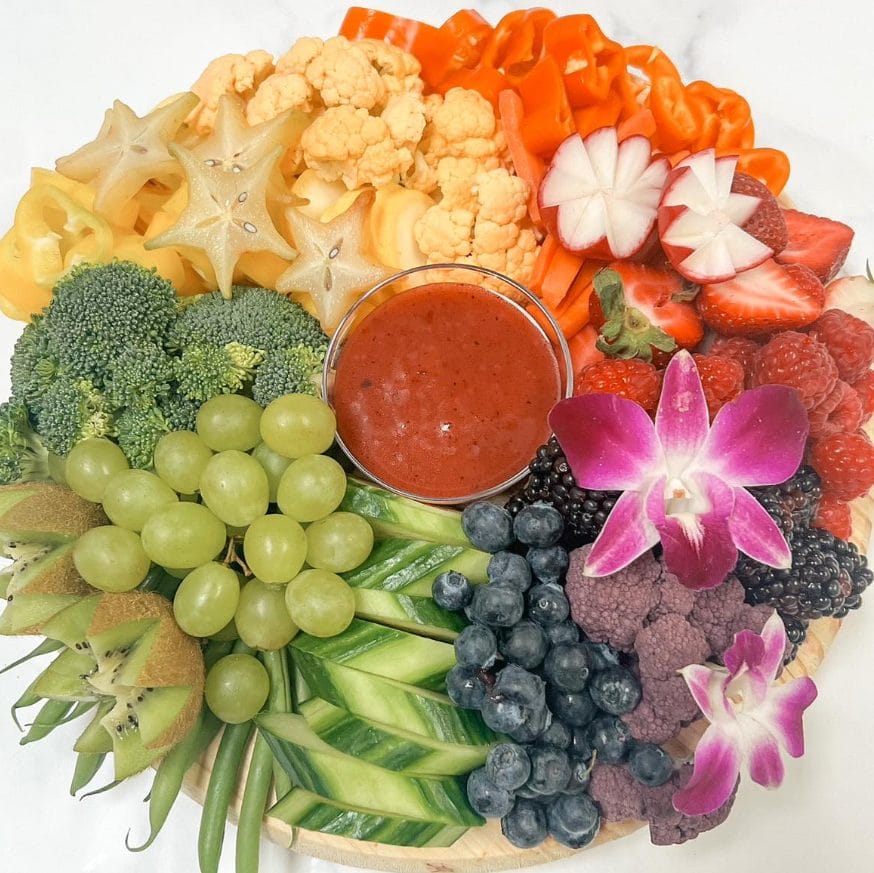
Common Questions and FAQs About Vegetarian Charcuterie Boards
When planning a vegetarian charcuterie board, you might have a few practical questions to ensure everything runs smoothly. Here are answers to some of the most common questions:
How Long Can a Charcuterie Board Sit Out?
General Guidelines:
- Room Temperature: Most charcuterie boards, including vegetarian options, can sit out at room temperature for about 2 hours. This timeframe ensures that perishable items like cheeses and dips remain safe to eat.
- Warm Conditions: In warmer conditions or if the room temperature exceeds 70°F (21°C), it’s best to limit the time to 1 hour to prevent spoilage.
- Food Safety: To keep items fresh and safe, consider using ice packs or a cooling tray if the board will be out for an extended period.
How to Store Leftovers?
Storage Tips:
- Cheeses: Wrap leftover cheese tightly in plastic wrap or place it in an airtight container to prevent it from drying out. Store in the refrigerator for up to 1 week.
- Vegetables and Fruits: Store leftover vegetables in airtight containers in the refrigerator. For fruits, store them separately and use within a few days to maintain freshness.
- Dips and Spreads: Transfer leftover dips and spreads to airtight containers and refrigerate. Most will keep for about 3-5 days, depending on the ingredients.
- Crackers and Bread: Keep leftover crackers in a resealable bag or airtight container to maintain their crispness. Store bread in a breadbox or sealed container to prevent it from becoming stale.
Can I Prepare a Charcuterie Board in Advance?
Preparation Tips:
- Advance Assembly: You can prepare most elements of the board in advance. Slice and arrange cheeses, chop vegetables, and prepare dips a day before the event. Store each component in airtight containers in the refrigerator.
- Final Assembly: For the best presentation, assemble the final board just before serving. Arrange pre-prepped ingredients on the board and add fresh garnishes right before guests arrive to ensure everything looks its best.
- Chilling: Keep the assembled board chilled until serving time, especially if it includes perishable items like cheese and dips.
What Are Some Budget-Friendly Ingredients?
Affordable Options:
- Cheeses: Opt for more economical cheeses like basic cheddar, mozzarella, or gouda. Store brands often offer good value without compromising quality.
- Vegetables: Choose seasonal vegetables, which are usually less expensive and fresher. Carrots, cucumbers, and bell peppers are budget-friendly options.
- Fruits: Buy fruits in bulk or choose less expensive options like apples, bananas, or seasonal berries. Frozen fruits can also be a cost-effective choice.
- Crackers and Bread: Look for store-brand or bulk options for crackers and bread. Whole grain crackers and artisanal bread are often affordable and add variety.
- Nuts and Seeds: Purchase nuts and seeds in bulk to save money. Sunflower seeds and almonds are often more affordable than specialty nuts.
How to Cater to Dietary Restrictions?
Dietary Considerations:
- Allergies: Clearly label all items on the board, especially if they contain common allergens like nuts, dairy, or gluten. Provide alternative options for guests with specific allergies.
- Gluten-Free: Include gluten-free crackers or bread, and make sure to avoid cross-contamination by keeping gluten-free items separate from those containing gluten.
- Vegan Options: Ensure that any vegan guests have suitable alternatives by including vegan cheese, dips, and spreads. Clearly separate these from non-vegan items.
- Low-Sodium or Low-Sugar: Offer options with reduced sodium or sugar, such as unsalted nuts or fresh fruits, to cater to guests with dietary restrictions related to these components.
By addressing these common questions, you can ensure your vegetarian charcuterie board is well-prepared, accommodating, and enjoyable for all guests.

Wrapping It Up
Creating a vegetarian charcuterie board is a fun and versatile way to enjoy a variety of flavors and textures. We've covered essential ingredients, health and environmental benefits, assembly tips, themed boards for various occasions, vegan options, and practical advice for parties and gatherings.
Try making your own vegetarian charcuterie board and experiment with different ingredients and themes. We'd love to see your creations and hear your tips, so feel free to share them in the comments or on social media. Happy board-making!
Frequently Asked Questions
Can a charcuterie board be vegetarian?
Yes, a charcuterie board can be vegetarian. Instead of traditional meats, a vegetarian charcuterie board features an array of fresh vegetables, fruits, cheeses, nuts, seeds, dips, and spreads. These ingredients create a colorful, flavorful, and satisfying spread that is perfect for vegetarians and those looking to enjoy more plant-based options.
What to put on a vegetarian grazing board?
A vegetarian grazing board can include a variety of delicious and colorful items. Consider adding fresh vegetables (like bell peppers, cherry tomatoes, cucumbers, and carrots), a selection of cheeses (such as brie, cheddar, and goat cheese), fresh and dried fruits (such as grapes, apples, berries, and apricots), nuts and seeds (like almonds, walnuts, and sunflower seeds), crackers and bread (including whole grain and gluten-free options), and dips and spreads (like hummus, guacamole, and pesto). You can also add sweet treats like dark chocolate or honey for extra variety.
What can I use instead of meat on a charcuterie board?
Instead of meat, you can use a variety of plant-based alternatives on a charcuterie board. Consider adding a selection of fresh vegetables (such as bell peppers, cherry tomatoes, and cucumbers), fruits (like grapes, apples, and berries), cheeses (both dairy and vegan options), nuts and seeds (such as almonds and walnuts), and flavorful dips and spreads (like hummus, guacamole, and tapenade). You can also include vegan meat alternatives like tempeh, seitan, or marinated tofu for added protein and texture.
What do you call a charcuterie board without meat?
A charcuterie board without meat is often called a vegetarian charcuterie board or a grazing board. It features an assortment of vegetables, fruits, cheeses, nuts, seeds, dips, and spreads, offering a delicious and visually appealing alternative to traditional meat-based charcuterie boards
Share Your Creations:
We’d love to see the charcuterie boards you create using our guide! Feel free to share your own creations in the comments or on social media, and tag us for a chance to be featured. And if you have any other ideas or tips for creating the perfect charcuterie board, we’d love to hear them.

